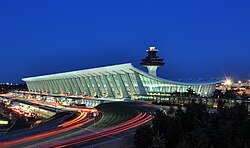Colonial period, 19th century
During the colonial period, the Virginia Colony was dependent upon the waterways as avenues of commerce, and James River Plantations such as John Rolfe's Varina Farms with their own wharfs on the rivers of the Fall Line (at present-day Richmond were soon shipping tobacco and other export crops abroad. Other important navigable rivers in this period were the Elizabeth, York, and Potomac.
By the 19th century, the Virginia Board of Public Works was funding transportation infrastructure improvements, stimulating such private enterprises as the James River and Kanawha Canal, the Chesterfield Railroad, and the Valley Turnpike. Claudius Crozet's innovative tunnels under the Blue Ridge Mountains were a key link in Collis P. Huntington's railroad linking Virginia to the Ohio River Valley in 1873. Soon thereafter, Pocahontas coal was riding the rails from the mountains eastbound for export via the Chesapeake and Ohio, Norfolk and Western and Virginian Railways with coal piers on Hampton Roads.
20th-21st centuries
With urging from the state chapter founded in Roanoke in 1894 of the National Good Roads Movement, in 1906 the Virginia General Assembly created the first State Highway Commission. In 1932, the state's role was expanded when the provisions of the Byrd Road Act during the Great Depression brought most secondary roads in the counties into the scope of state control and maintenance.
In the mid-20th century, Virginia's Henry G. Shirley Memorial Highway in Northern Virginia pioneered HOV and reversible traffic lanes. Prior to the creation of the Interstate Highway System, Virginia had some other notable roads to handle heavy traffic including Military Highway in South Hampton Roads, Mercury Boulevard on the Virginia Peninsula, and State Route 168, which extended from west of Williamsburg to the North Carolina border near the eastern edge of the Great Dismal Swamp, including Tidewater Drive in the Norfolk area. The Richmond-Petersburg Turnpike was built to relieve heavy traffic on US1-301 between those two cities.
In 1957, The Hampton Roads Bridge-Tunnel, first of its kind, was completed, and was soon incorporated into Interstate 64. The Chesapeake Bay Bridge-Tunnel completed in 1964 is the longest bridge-tunnel in the world. Interstate highways I-81 and I-95 are some of the busiest roads of commerce on the East Coast.
Of course, people and property continue to travel by ship, as the first settlers did. The Atlantic Ocean is accessed by the more sheltered Chesapeake Bay and Hampton Roads, with 5 major navigable rivers offering a wide choice of ports and industrial sites. International shipping traffic continues to grow as intermodal port and rail facilities are expanded. The Virginia Port Authority even operates an inland port in the Shenandoah Valley.
The Wright Brothers are credited with first flight just south of Virginia at Kitty Hawk, North Carolina. Other early flights took place at Willoughby Spit near Norfolk. In modern times, major commercial airports are located around the state, with many additional general aviation facilities.
For those who wish to live in the past, at least for a visit, the Colonial Parkway, carefully shielded from commercial development, joins Colonial Williamsburg with Yorktown and Jamestown, the three points of the Historic Triangle. By riding the toll free Jamestown Ferry service across the James River, it is even possible to arrive at Jamestown Island by water, with a similar view to that of the first colonists. Virginia's scenic byways include the Skyline Drive in Shenandoah National Park and the Blue Ridge Parkway. Even in busy Northern Virginia, a bucolic interlude is available inside the beltway on the George Washington Memorial Parkway. The state has literally dozens of other stretches of roads designated as scenic byways, and VDOT distributes a free map showing them.













